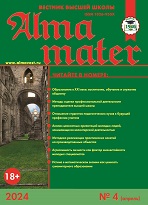UDC 304:378::004
https://doi.org/10.20339/AM.04-20.084
Yu.I. Butenko is Cand.Sci. (Engineering), doc. e-mail: iuliiabutenko2015@yandex.ru; N.O. Trufanova is Cand.Sci. (Philology), doc., head of sub-faculty e-mail: ntroufanova@mail.ru ; and A.D. Fedorin is student e-mail: artem.fedorin@bk.ru at N.E. Bauman Moscow State Technical University
Presented is statistical study on the use of modern remote communication means, in particular social networks, in educational process at technical university. Comparative analysis of social networks usage is carried out by means of questionnaire survey of students and their teachers. Results of the survey on attitude of students and teachers to use of social networks in educational process are analyzed. Multimedia, popular among students and teachers in social networks used for educational purposes were singled out.
Keywords: statistical research, education, social networks, analysis, teacher, survey.
References
- Abdullayeva, R.A. Analysis of social networks influence on modern society life. International Journal of Applied and Fundamental Research. 2015. No. 9-3. P. 542–546.
- Butenko, Yu. I., Semenova, E.L., Kazantseva, E.S., Kiseleva, A.D. Development of English language learning course elements in Moodle environment. Alma mater (Vestnik vysshei shkoly). 2019. No. 8. P. 73–77.
- Higher school: traditions and innovations. Actual issues and problems of the education system of the Russian Federation. Moscow, 2019.
- Klimenko, O.A. Social networks as a means of training and interaction of the educational process participants. In: Theory and practice of education in the modern world. St. Petersburg, 2012. P. 405–407.
- Lyapuntsova, E.В. Influence of digital technologies on value of traditional education system. In: Strategic guidelines of higher school development. Moscow, 2019. P. 436–438.
- Sidnyaev, N.I.; Butenko, Yu.I. Concept of the processes of perception and understanding of speech of the lecturer of the technical university. In: Modern Technological Education. Moscow, 2019. P. 274–290.
- Sidnyaev, N.I, Sobolev, S.K. Formation of the final assessment of the discipline within the rating system. Alma mater (Vestnik vysshei shkoly). 2018. No. 12. P. 51–56.
- Social networks. URL: http://internet-reklama.by/c/термины/все-термины/социальные-сети
- Barnes, N.G., Lescault, A. Social media adoption soars as higher-ed experiments and reevaluates its use of new communications tools. Center for Marketing Research. University of Massachusetts Dartmouth, North Dartmouth, MA. 2011. P. 5–10.
- Inozemtseva, K., Kirsanova, G., Troufanova, N., Semenova, Y. Using ThingLink Digital Posters in Teaching ESP to Engineering Students (A Case Study of Bauman Moscow State Technical University). In: Proceedings of 11th International Conference of Education, Research and Innovation (ICERI2018) Conference 12–14th November 2018, Sevilla, Spain. P. 3487–3492.
- Tarasyev, A.A., Agarkov, G., Medvedev, A. Optimization of educational paths for higher education. AIP Publishing. 2017. No. 1. P. 07–08.
- WEB-Index Media Scorpe. URL: https://webindex.mediascope.net/top-resources
- Williams, P.E. Roles and competencies for distance education programs in higher education institutions. The American Journal of Distance Education. 2003. No. 1. P. 45–57.











.png)






